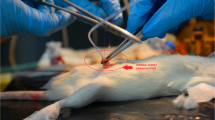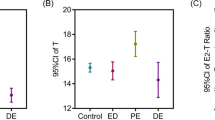Abstract
Declining testosterone (T) in an aging male offsets the equilibrium between androgen and oestrogen (oestradiol, E2) with a resultant increase in E2–T ratio. Similar functional hormone imbalance is existent in clinical states of hypogonadism and is likely to arise from exposure of males to environmental oestrogens. The pathophysiological significance of this derangement on erectile function, hitherto unknown, was estimated in sexually mature male rats following acute and chronic treatment with oestrogen. A total of 60 male Sprague–Dawley rats (200–250 g) were divided into control and two treatment groups, administered 0.01 and 0.1 mg of oestradiol through oral gavage daily for 1 week (n=30, acute study) and 12 weeks (n=30, long-term study), respectively. Sexual activity in the presence of hormonally primed female rats and intracavernous pressure (ICP) response to electrical stimulation estimated treatment-induced changes, which were correlated with hormone levels and penile morphology at 12 weeks. Following two to five–fold elevation in serum E2 levels (and simultaneous reduction in testosterone), there was a significant prolongation of mount, intromission, ejaculation latencies and some decrease in frequencies. The ICP response to nerve stimulation was also impaired in all the treated groups. Histologically, trichrome staining highlighted the cavernosal connective tissue hyperplasia in the long-term study groups. Results of this investigation indicate that oestradiol causes pathophysiological changes in erectile function. These observations provide an indirect evidence for the possible sexual health hazards in man upon inadvertent exposure to environmental oestrogens, ageing and derangement of E2–T ratio.
This is a preview of subscription content, access via your institution
Access options
Subscribe to this journal
Receive 8 print issues and online access
$259.00 per year
only $32.38 per issue
Buy this article
- Purchase on Springer Link
- Instant access to full article PDF
Prices may be subject to local taxes which are calculated during checkout




Similar content being viewed by others
References
Gray A, Fieldman HA, McKinlay JB, Longcope C . Age, disease and changing sex hormone levels in middle-aged men: results of the Massachusetts male aging study. J Clin Endocrinol Metab 1991; 73: 1016–1025.
Tserotas K, Merino G . Andropause and the aging male. Arch Androl 1998; 40: 87–93.
Zvara P et al. Nitric oxide mediated erectile activity is a testosterone dependent event: a rat erection model. Int J Impot Res 1995; 7: 209–219.
Cohen PG . The role of oestradiol in the maintenance of secondary hypogonadism in males in erectile dysfunction. Med Hypotheses 1998; 50: 331–333.
Sharpe RM . Reproductive biology: do males rely on female hormones? Nature 1997; 390: 447–448.
Hess RA et al. A role for oestrogens in the male reproductive system. Nature 1997; 390: 509–512.
Harman SM, Tsitouras PD . Reproductive hormones in aging men. I. Measurement of sex steroids, basal luteinizing hormone and Leydig cell response to human chorionic gonadotropin. J Clin Endocrinol Metab 1980; 51: 35–40.
Rubens R, Dhont M, Vermeulen A . Further studies on Leydig cell function in old age. J Clin Endocrinol Metab 1974; 39: 40–45.
Tenover JL . Male hormone replacement therapy including ‘andropause’. I. Gonadal disorders. Endocrinol Metab Clin North Am 1998; 27: 969–987.
Thomas DB . Breast cancer in men. Epidem Rev 1993; 15: 220–231.
Srilatha B, Adaikan PG, Ng SC . Evidence for oestrogen-mediated erectile dysfunction. In: Proceedings of the Second Combined Annual Scientific Meeting. National University Hospital, Singapore, 2000, p 65.
Srilatha B . Effects of hypercholesterolaemia and some antihypertensive drugs on erectile physiology. MSc thesis, National University of Singapore, 1998, pp 1–173.
Srilatha B, Adaikan PG, Arulkumaran S, Ng SC . Sexual dysfunction related to antihypertensive agents: results from the animal model. Int J Impot Res 1999; 11: 107–113.
Srilatha B, Adaikan PG, Ng SC, Arulkumaran S . Elevated low-density lipoproteins cholesterol (LDL-C) enhances pro-erectile neurotransmission in the corpus cavernosum. Int J Impot Res 1999; 11: 159–165.
Brewster ME, Anderson WR, Pop E . Effect of sustained estradiol release in the intact male rat: correlation of estradiol serum levels with actions on body weight, serum testosterone and peripheral androgen-dependent tissues. Physiol Behav 1997; 61: 225–229.
Ogawa S, Lubahn DB, Korach KS, Pfaff DW . Behavioural effects of estrogen receptor gene disruption in male mice. Proc Natl Acad Sci USA 1997; 94: 1476–1481.
Jung GW, Hur GY, Kim DW, Yoon JH . Erectile function, histologic changes of the penis and testis according to long-term estrogen exposure. Int J Impot Res 2000; 12 (Suppl 2): S10.
Martinez-Pineiro L et al. Rat model for the study of penile erection: pharmacologic and electrical stimulation parameters. Eur Urol 1994; 25: 62–70.
Gooren LJ . Endocrine aspects of ageing in the male. Mol Cell Endocrinol 1998; 145: 153–159.
Adaikan PG, Bayasgalan G, Lau LC, Ng SC . Effect of testosterone and growth hormone on sexual function in aged male rats. In: Proceedings of the First Asian ISSAM Meeting on the Aging Male. Kuala Lumpur 2001, p 69.
Gill-Sharma MK et al. Antifertility effects of estradiol in adult male rats. J Endocrinol Invest 2001; 24: 598–607.
Gooren L . Improvement of spermatogenesis after treatment with the antiestrogen tamoxifen in a man with the incomplete androgen insensitivity syndrome. J Clin Endocrinol Metab 1989; 68: 1207–1210.
Cheek AO, McLachlan JA . Environmental hormones and the male reproductive system. J Androl 1998; 19: 5–10.
Acknowledgements
The authors gratefully acknowledge the award of research grant R-174-000-068-213 by the National Medical Research Council (NMRC), Singapore.
Author information
Authors and Affiliations
Corresponding author
Rights and permissions
About this article
Cite this article
Adaikan, P., Srilatha, B. Oestrogen-mediated hormonal imbalance precipitates erectile dysfunction. Int J Impot Res 15, 38–43 (2003). https://doi.org/10.1038/sj.ijir.3900945
Received:
Revised:
Accepted:
Published:
Issue Date:
DOI: https://doi.org/10.1038/sj.ijir.3900945
Keywords
This article is cited by
-
Estrogenic endocrine disruptor exposure directly impacts erectile function
Communications Biology (2024)
-
Hormonal correlations of premature ejaculation
Endocrine (2015)
-
Limited effect of testosterone treatment for erectile dysfunction caused by high-estrogen levels in rats
International Journal of Impotence Research (2013)
-
Endocrine milieu and erectile dysfunction: is oestradiol–testosterone imbalance, a risk factor in the elderly?
Asian Journal of Andrology (2011)
-
Activity of single components of Ferula hermonis on male rat sexual behavior
International Journal of Impotence Research (2005)



